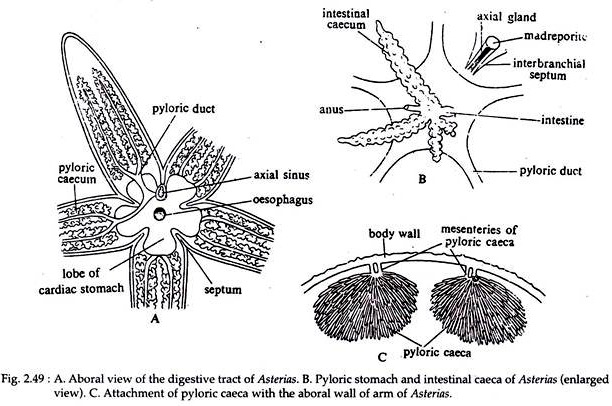In this article we will discuss about the Macrophagy in Star Fish:- 1. Introduction to Star Fish 2. Feeding Organs in Star Fish 3. Digestive System 4. Feeding and Digestion.
Introduction to Star Fish:
Asterias or Star fish is the member of Phylum Echinodermata, sub-phylum Asterozoa and class Asteroidea. They are marine and benthic in habit and widely distributed throughout the world. They prefer to stay on rocky or stony places where they can hide very easily and lead a sluggish life. Starfishes are carnivorous and predacious animals. They prefer bivalve as food.
Feeding Organs in Star Fish:
Food is captured by the arms assisted by tube feet. Star fish has a five pointed star shaped body. The body consists of a central disc and five symmetrically placed arms. The body has two surfaces — upper aboral and lower oral.
At the centre of the oral surface of the central disc, a five rayed aperture called the mouth is present. Five narrow ambulacral grooves, one on each arm, run orally from the mouth to the extremity of the arms (Fig. 1.129).
ADVERTISEMENTS:
Two double rows of tube feet or podia are present in the ambulacral grooves. Each tube foot or podium has a soft tubular body that ends in a sucker. A minute red spot, the eye, is present at the extremity of the ambulacral groove on the oral side. Just above the eye, lies a median unpaired terminal tentacle. This tentacle is regarded as an olfactory organ.
Digestive System in Star Fish:
The digestive system (Fig. 2.49) comprises of alimentary canal and digestive glands. The alimentary canal is a very short straight tube. It extends from the oral to the aboral side of the body. The mouth is located near the centre of the oral surface.
The mouth leads into a very short and wide oesophagus. The oesophagus passes into a spacious stomach (Fig. 2.49A). The stomach is distinctly divided into two parts by a horizontal constriction.
The voluminous anterior portion is called the cardiac stomach and the smaller posterior chamber is called the pyloric stomach. The cardiac stomach is a five-lobed sac. Its inner wall becomes greatly folded. The cardiac part is capable of being everted through the mouth.
ADVERTISEMENTS:
The cardiac stomach communicates with the pyloric stomach. The pyloric stomach is a pentagonal sac and each angle is produced into a pair of large glandular appendages. There are, in all, ten such glandular structures. These have various names such as pyloric caeca or digestive glands or hepatic caeca (Fig. 2.49C).
The pyloric caeca are glandular in nature and secrete digestive enzymes. They start as cylindrical duct which immediately divide into two tubular stems. The tubular stems give off two series of short lateral branches.
The stem extends up to the tip of the arms. The lateral branches dilate at their tips to form numerous small pouches. The pyloric caeca are attached with the aboral wall of the arm by mesenteries (Fig. 2.49C).
ADVERTISEMENTS:
The pyloric caeca is lined by four types of cells:
(i) Flagellated cells—with long flagella to maintain a constant circulation of fluid.
(ii) Secretory cells—produce digestive enzymes.
(iii) Mucous cells—secrete mucus.
(iv) Storage cells—contain lipid, glycogen, polysaccharide protein complex as storage food.
The pyloric stomach opens into a short conical intestine which opens to the exterior through anal aperture situated on the aboral side. From the intestine, two hollow intestinal caeca are given off inter-radially (Fig. 2.49B).
These intestinal caeca are provided with several short irregular branches. The greatly folded inner lining of the intestinal caeca contains mucous and gland cells. These are brownish in colour and secrete brown coloured fluid.
The histological picture of the alimentary canal reveals that the outer layer is composed of the visceral layer of the coelomic epithelium. The next layer is the muscular layer and the innermost layer comprises of endoderm or enteric epithelium.
Feeding and Digestion in Star Fish:
Star fish almost exclusively feed on bivalves. In rare cases small, crustacea and even small fishes are known to be taken by them. With the help of eye and tentacles they locate the prey. It is reported that they locate the prey species by certain substances released by the prey itself into the water.
ADVERTISEMENTS:
During feeding, the star fish extends itself over the mussel, holding the gape of the mussel upward against its mouth and applying its arms against the sides of the mussel valves. The star fish can insert the everted stomach through the minute opening between the two valves.
The opening may be formed due to imperfect realing of the edges or may be due to the pull exerted by the arms of the star fish. It is reported that the everted cardiac stomach of some star fishes can squeeze through a space as less as 0.1 mm.
The process of everting the stomach through mouth and taking food directly from outside into the stomach is called as extra oral feeding. Through the contraction of body wall muscles, the coelomic fluid exerts pressure on the cardiac stomach, causing it to be everted through the mouth.
The everted stomach enters into the cavity of the shell of the bivalve prey. The enzymes secreted by the stomach make the soft parts of the victim reduced to a thick broth. This broth then passes into the body in ciliated gutters.
Following extracellular digestion, the stomach muscles contract, retracting the stomach into the interior of the disc. The product of stomach digestion are carried by ciliary tracts and reaches the pyloric caeca through the pyloric duct.
Into the pyloric caeca further digestion takes place and absorption of digested materials is performed. The absorbed materials may be stored in the cell of pyloric caeca or passed through the caeca into the coelom for distribution. The undigested materials are conveyed out of the rectum as wastes.
